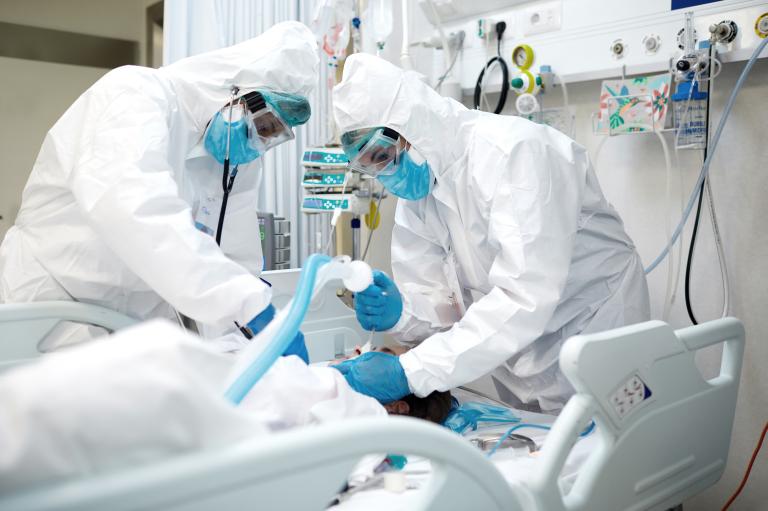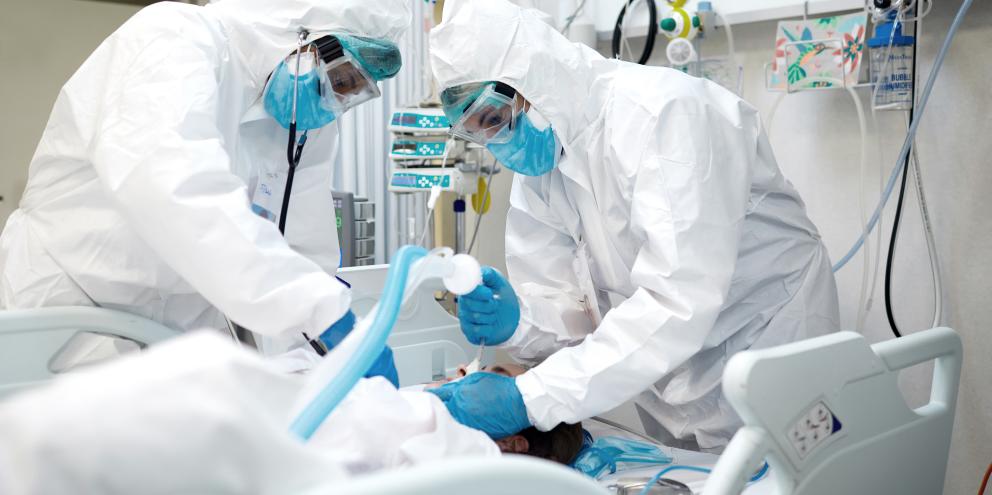
The British Medical Journal (BMJ) reports that healthcare workers may be up to seven times more likely than workers in other occupations to develop severe COVID-19 symptoms. 2
These findings illustrate how the nature of healthcare work puts critical care nurses, doctors, therapists and others at elevated risk from direct contact with infected people.
Clearly, better and more aggressive infection controls in ICUs are critical to reducing COVID-19 deaths. At the same time, lessons learned from recent years’ experience can be applied to help keep caregivers and their patients safe from all infectious diseases, including COVID-19, now and in the future. Effective blocking of disease transmission in ICUs requires merging a variety of pre- and peri-pandemic infection control strategies.
Maximizing Protection from PPE Equipment
At the onset of the COVID-19 pandemic, critical care nurses at the bedsides quickly saw the need for better personal protective equipment (PPE). Advanced protections already common during routine intensive care were supplemented with additional single-use PPE.
Healthcare facilities employed varied policies and used PPE in different ways. A study in the Critical Care Journal describes how some facility leaders required staff to wear disposable masks over N95 respirators.3 Elsewhere, clinicians were told to wear face shields in addition to goggles to limit exposure to airborne droplets containing COVID-19. Rates of infection among caregivers were substantially lower in hospitals where these added precautions were taken. The same practices could be used amid other viral outbreaks, depending on the specific nature of the virus.
In deciding whether these practices are appropriate, nurse leaders must assess the need for more staff training in putting on and removing PPE. To help prevent adverse events from improper wearing and use of PPE, prescribed donning and doffing sequences for critical care staff members may be necessary.
Decontaminating Disposable PPE: Pros and Cons
One question related to PPE is whether disposable items can be effectively disinfected and reused. Early in the pandemic, the FDA recommended crisis capacity strategies including the decontamination of disposable respirators to help deal with shortages of supply.4 Multiple decontamination systems have been developed to provide caregivers with N95 respirators. A study in PLOS ONE showed that most decontamination procedures, such as autoclaving, eliminated viable viruses from masks5. On the other hand several rounds of such decontamination were shown to compromise the respirators’ structural integrity, hindering the formation of a proper seal against the wearer’s face.5
Companies have since ramped up production of respirators for ICU use. Accordingly, the FDA now recommends using decontaminated respirators only when no other filtering facepiece respirators are available.6
Buffer Zones and Isolation Rooms
Buffering and isolation areas have potential to provide further protection to ICU workers. The Critical Care study mentioned earlier described the use of specific buffer zones designed to isolate COVID-19 contamination. Before entering patient-care areas, nursing staff members put on all PPE in designated clean areas. After delivering care, they removed the PPE in a nearby buffer area. A second buffer zone then provided a transition to the clean zone. This enabled staff to remove all remaining PPE and then perform personal hygiene tasks before they re-entered normal work areas. The study found that the isolation zones helped mitigate COVID-19 transmission among nursing staff; such zones could also help protect against other highly infectious viruses.
Preventing Transmission Through Specimens
The Centre for Evidence-Based Medicine suggests that COVID-19 may be present not only in respiratory specimens but also in serum, saliva, urine, and stool.7 This would require the use of advanced infection control practices in handling and processing of all such specimens.
The Indian Journal of Critical Care Medicine suggests how procedures could be changed to better protect healthcare workers and patients.8 After collecting any specimen from a COVID-19 patient, the staff member should place it in triple packaging and deliver it immediately to the laboratory. Persons collecting and transporting specimens should wear additional PPE. Beyond COVID-19, these practices could be followed for any specimen containing large amounts of infectious viruses or bacteria.
Looking to the Future
Infection control in the ICU will likely continue to evolve as doctors learn more about contagious diseases like COVID-19. In the meantime, nurse leaders and others should continue reviewing current evidence to identify best practices for protecting healthcare workers.
References
- https://www.cdc.gov/mmwr/volumes/69/wr/mm6943e3.htm
- https://www.bmj.com/company/newsroom/healthcare-workers-7-times-as-likely-to-have-severe-covid-19-as-other-workers/
- https://ccforum.biomedcentral.com/articles/10.1186/s13054-020-03076-1
- https://www.fda.gov/medical-devices/coronavirus-disease-2019-covid-19-emergency-use-authorizations-medical-devices/decontamination-systems-personal-protective-equipment
- https://journals.plos.org/plosone/article?id=10.1371/journal.pone.0243965
- https://www.fda.gov/medical-devices/letters-health-care-providers/fda-recommends-transition-use-decontaminated-disposable-respirators-letter-health-care-personnel-and
- https://www.cebm.net/study/viable-sars-cov-2-in-saliva-urine-and-stool-from-covid-19-patients/
- https://www.ncbi.nlm.nih.gov/pmc/articles/PMC7724928/








